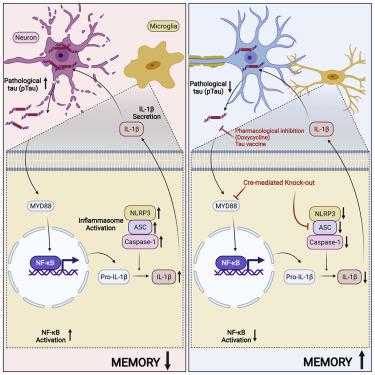Cell Reports ( IF 7.5 ) Pub Date : 2021-09-21 , DOI: 10.1016/j.celrep.2021.109720 Shanya Jiang 1 , Nicole M Maphis 1 , Jessica Binder 1 , Devon Chisholm 1 , Lea Weston 1 , Walter Duran 1 , Crina Peterson 2 , Amber Zimmerman 2 , Michael A Mandell 1 , Stephen D Jett 3 , Eileen Bigio 4 , Changiz Geula 4 , Nikolaos Mellios 2 , Jason P Weick 2 , Gary A Rosenberg 5 , Eicke Latz 6 , Michael T Heneka 7 , Kiran Bhaskar 8

|
Pathological hyperphosphorylation and aggregation of tau (pTau) and neuroinflammation, driven by interleukin-1β (IL-1β), are the major hallmarks of tauopathies. Here, we show that pTau primes and activates IL-1β. First, RNA-sequence analysis suggests paired-helical filaments (PHFs) from human tauopathy brain primes nuclear factor κB (NF-κB), chemokine, and IL-1β signaling clusters in human primary microglia. Treating microglia with pTau-containing neuronal media, exosomes, or PHFs causes IL-1β activation, which is NLRP3, ASC, and caspase-1 dependent. Suppression of pTau or ASC reduces tau pathology and inflammasome activation in rTg4510 and hTau mice, respectively. Although the deletion of MyD88 prevents both IL-1β expression and activation in the hTau mouse model of tauopathy, ASC deficiency in myeloid cells reduces pTau-induced IL-1β activation and improves cognitive function in hTau mice. Finally, pTau burden co-exists with elevated IL-1β and ASC in autopsy brains of human tauopathies. Together, our results suggest pTau activates IL-1β via MyD88- and NLRP3-ASC-dependent pathways in myeloid cells, including microglia.
中文翻译:

蛋白病 tau 通过骨髓细胞特异性 MyD88 和 NLRP3-ASC 炎症小体途径启动并激活白细胞介素 1β
由白细胞介素 1β (IL-1β) 驱动的 tau (pTau) 病理性过度磷酸化和聚集以及神经炎症是 tau 蛋白病的主要标志。在这里,我们证明 pTau 启动并激活 IL-1β。首先,RNA 序列分析表明,来自人 tau 蛋白病大脑的成对螺旋丝 (PHF) 会启动人原代小胶质细胞中的核因子 κB (NF-κB)、趋化因子和 IL-1β 信号簇。用含有 pTau 的神经元介质、外泌体或 PHF 处理小胶质细胞会导致 IL-1β 激活,这是 NLRP3、ASC 和 caspase-1 依赖性的。抑制 pTau 或 ASC 分别减少 rTg4510 和 hTau 小鼠的 tau 病理学和炎症小体激活。尽管 MyD88 的缺失会阻止 hTau 小鼠 tau 病模型中 IL-1β 的表达和激活,但骨髓细胞中的 ASC 缺陷会减少 pTau 诱导的 IL-1β 激活并改善 hTau 小鼠的认知功能。最后,在人类 tau 病尸检大脑中,pTau 负荷与升高的 IL-1β 和 ASC 共存。总之,我们的结果表明 pTau 通过 MyD88 和 NLRP3-ASC 依赖的骨髓细胞(包括小胶质细胞)途径激活 IL-1β。











































 京公网安备 11010802027423号
京公网安备 11010802027423号